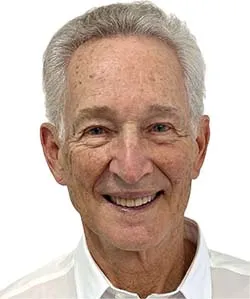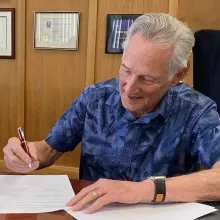UArizona Wyant College of Optical Sciences Announces the Murray Sargent III Endowed Chair in Quantum Optics

The University of Arizona James C. Wyant College of Optical Sciences announced a $2 million donation from Murray and Kamie Sargent to establish the Murray Sargent III Endowed Chair in Quantum Optics. This endowment will provide support to a faculty member specializing in the increasingly impactful field of quantum optics.
“The extraordinary generosity from Murray and Kamie Sargent will have a tremendous impact on our faculty and on the groundbreaking research being performed at the College,“ said Thomas L. Koch, dean, Wyant College of Optical Sciences. “Because of his renowned accomplishments in this field, having an endowed chair bearing Murray’s name unquestionably enhances our ability to recruit and retain faculty members who will make transformational discoveries in the field of quantum optics.”
“Kamie and I have always believed in how scientific discoveries find solutions to global problems,” said Murray, PhD, professor emeritus with the University of Arizona. “Investing in faculty and their students is the best way we can think of to enable learning and advance discoveries. With its outstanding faculty and interdisciplinary approach, the Wyant College of Optical Sciences is positioned to inspire the scientists of the future and change the world for the better- and we are proud to help keep this College at the forefront with the education and research of quantum optics.”
The Sargents support of faculty was amplified through the Eminent Scholars Program managed by the University’s Provost Office and the University of Arizona Foundation. This state-funded program matches philanthropic investments for the recruitment and retention of faculty at Arizona universities. At the University of Arizona, the program provides a 1:1 match for the payout of a newly established endowed faculty position for five years and a one-time award for graduate students working with the endowed chair recipient.
“Faculty are the backbone of the University. Their work draws top students, and brings new knowledge into the world,” said John-Paul Roczniak, President and CEO, University of Arizona Foundation. “I am grateful to the Sargents for their visionary support of faculty and quantum optics.”
Murray Sargent III
Dr. Murray Sargent III earned his undergraduate and graduate degrees in theoretical physics from Yale University where his PhD advisor was Nobel Laureate Dr. Willis E. Lamb, Jr. (who would later join the faculty of the University of Arizona’s Optical Sciences Center).
Receiving his PhD from Yale in 1967, Murray started his career at Bell Laboratories in Holmdel, New Jersey, continuing his research interests in laser physics. Murray also had an early interest in adapting computers for typesetting complex mathematical equations, creating the first computer language for this purpose - SCROLL (String and Character Recording Oriented Logogrammatic) with the encouragement of Ralph Griswold and colleagues at Homdel.
In 1969, Drs. Marlon Scully and Stephen Jacobs convinced Murray to join the University of Arizona Optical Sciences Center as a faculty member in its original quantum optics group. Here, he worked on theories for many laser phenomena including ring lasers, distributed feedback lasers, semiconductor lasers mode locking and multiwave mixing. He also continued his interest in computer programming languages, teaching a special studies computer science program at the University’s Department of Electrical Engineering. To promote computer science at the University, he convinced Ralph Griswold to join the University, becoming its first professor of computer science who subsequently created the department and remained head until 1981. Murray also developed the PS technical word processor (1980s) which was often used at the Optical Sciences Center and also to typeset some of his own papers and books.
He also developed the SST debugger, which could run real-mode programs in protected mode, thereby enabling them to access all of memory instead of just 640 kilobytes. This caught the eye of Microsoft. While still a professor at the University, Murray accepted a consulting role during the summer months to help Microsoft’s CodeView debugger run in protected mode. This effort led to running Microsoft Windows 3.0 in protected mode without the famous 640 kilobyte RAM barrier. Then in 1992, he accepted a full-time position at Microsoft with a goal of enabling better display and editing of mathematical text in Microsoft Office. He later moved to the Microsoft Office Business Unit to work on the RichEdit text editor and Microsoft Office math.
His contributions to science include authoring over 100 publications in scientific journals and coauthoring seven books – three on laser physics and four on personal computers. He holds four patents and wrote monthly posts for his blog, Math in Office, from 2006 to 2023.
Avid outdoors people, Murray and Kamie enjoy travel, bike riding, skiing, scuba diving and hiking/trekking. Murray day hiked the Grand Canyon rim-to-rim twice and summited Mount Baker (10,781 feet) and Mount Rainer (14,411 feet). In 2010, the couple trekked to the Mt. Everest base camp and summited Kala Pathhar, at an elevation of 18,514 feet. Other treks included the Annapurna Circuit, Mt. Kilimanjaro, Machu Picchu and the Haute Route from Chamonix to Zermatt.
In addition to their recent endowed chair donation, the Sargents previously made significant gifts to the University of Arizona helping to establish the Willis Lamb, Jr. Graduate Student Scholarships in Optical Sciences.
Quantum Optics at UA

Murray Sargent III Signs for the new Murray Sargent III Endowed Chair in Optical Sciences.
The rich history of Quantum Optics at the Wyant College of Optical Sciences has positioned the University of Arizona to be a leader in advancing both the frontiers of fundamental physics and in exciting new real-world applications in Quantum Information Sciences and Engineering (QISE). Current research includes optical control of quantum systems, novel quantum sensor and measurement technologies, and quantum optical communications and networking. The Wyant College of Optical Sciences is spearheading materials, devices and system architectures for “quantum repeaters” which will enable the connection and quantum entanglement of remote quantum computers and sensors to achieve unprecedented new functionality. As a lead for the National Science Foundation “Center for Quantum Networks” Engineering Research Center, the College’s faculty team and students are concentrating on advances to create the future quantum internet.
“Our work will revolutionize how humankind computes, communicates and senses the world by creating a fabric to connect quantum computers, data centers and gadgets using their native quantum information states of quantum bits or qubits,“ Koch explained.
“When considering the college’s thriving research history in quantum optics, it will continue to be an exciting growth area of research for us. This new endowed chair will have a major role in supporting exceptionally brilliant faculty who will also attract top-flight students who are interested in this field. Investing in our faculty, just as Murray and Kamie have done, will continue to provide rich, lasting dividends—to our students, to the University, and to society,” Koch said.
Contact
Kaye Rowan, Executive Director of Development
UArizona Wyant College of Optical Sciences
rowan@optics.arizona.edu
520-626-8754
